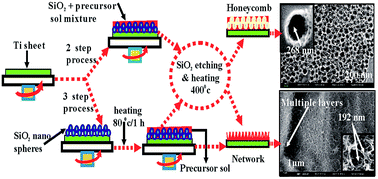Controlled fabrication of hierarchically porous Ti/Sb–SnO2 anode from honeycomb to network structure with high electrocatalytic activity†
Abstract
A simple template removal method has been developed for fabrication of hierarchically porous Sb doped SnO2 electrode with high porosity, effective electroactive sites, and enhanced electrocatalytic efficiency. Two different kinds of hierarchically porous architectures (Ti/Sb–SnO2-honeycomb and Ti/Sb–SnO2-network) with remarkable porosity and layer by layer arrangement in multiple directions are fabricated as observed by SEM measurements. EDS confirms the uniform distribution of Sb, Sn and O on substrate surface and the peaks of XRD at 33.9° and 51.8° proves the presences of rutile SnO2. Linear sweep voltammetry shows the Ti/Sb–SnO2-honeycomb and Ti/Sb–SnO2-network possess high OEP value upto 2.60 V, and 2.76 V. By analyzing CV curves, the recorded total voltammetric charge for hierarchically porous electrodes is boosted upto 7.46 mC cm−2 and 11.96 mC cm−2, compared to the conventional one (3.0 mC cm−2), which indicates the significant enhancement in electrochemical active sites. The electrocatalytic efficiency is explored by degradation of Rhodamine B under different parameters (pH, current density, and concentration). The reaction rates for Ti/Sb–SnO2-honeycomb and Ti/Sb–SnO2-network are 9.2 × 10−2 min−1 and 19.7 × 10−2 min−1, respectively, which are 2.2 and 4.7 times higher than conventional one (k = 4.2 × 10−2 min−1). Further mechanistic study suggests that more electroactive sites provided by hierarchically porous electrodes lead to accelerate HO˙ generation and the channels of porous structure significantly promotes the adsorption and diffusion of pollutant molecules.


 Please wait while we load your content...
Please wait while we load your content...